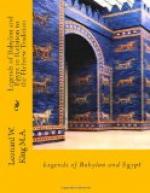(2) Cf. Poebel, Hist. Texts, p. 51 f. With the god’s apparent subterfuge in the third of these supposed versions Sir James Frazer (Ancient Stories of a Great Flood, p. 15) not inaptly compares the well-known story of King Midas’s servant, who, unable to keep the secret of the king’s deformity to himself, whispered it into a hole in the ground, with the result that the reeds which grew up there by their rustling in the wind proclaimed it to the world (Ovid, Metamorphoses, xi, 174 ff.).
(3) Op. cit., p. 51;
cf. also Jastrow, Heb. and Bab.
Trad., p. 346.
So far from Berossus having missed the original significance of the narrative he relates, I think it can be shown that he reproduces very accurately the sense of our Sumerian text; and that the apparent discrepancies in the Semitic Version, and the puzzling references to a wall in both it and the Sumerian Version, are capable of a simple explanation. There appears to me no justification for splitting the Semitic narrative into the several versions suggested, since the assumption that the direct warning and the dream-warning must be distinguished is really based on a misunderstanding of the character of Sumerian dreams by which important decisions of the gods in council were communicated to mankind. We fortunately possess an instructive Sumerian parallel to our passage. In it the will of the gods is revealed in a dream, which is not only described in full but is furnished with a detailed interpretation; and as it seems to clear up our difficulties, it may be well to summarize its main features.
The occasion of the dream in this case was not a coming deluge but a great dearth of water in the rivers, in consequence of which the crops had suffered and the country was threatened with famine. This occurred in the reign of Gudea, patesi of Lagash, who lived some centuries before our Sumerian document was inscribed. In his own inscription(1) he tells us that he was at a loss to know by what means he might restore prosperity to his country, when one night he had a dream; and it was in consequence of the dream that he eventually erected one of the most sumptuously appointed of Sumerian temples and thereby restored his land to prosperity. Before recounting his dream he describes how the gods themselves took counsel. On the day in which destinies were fixed in heaven and earth, Enlil, the chief of the gods, and Ningirsu, the city-god of Lagash, held converse; and Enlil, turning to Ningirsu, described the sad condition of Southern Babylonia, and remarked that “the decrees of the temple Eninnu should be made glorious in heaven and upon earth”, or, in other words, that Ningirsu’s city-temple must be rebuilt. Thereupon Ningirsu did not communicate his orders directly to Gudea, but conveyed the will of the gods to him by means of a dream.
(1) See Thureau-Dangin,
Les inscriptions de Sumer et
d’Akkad, Cyl.
A, pp. 134 ff., Germ. ed., pp. 88 ff.; and
cf. King and Hall,
Eg. and West. Asia, pp. 196 ff.




